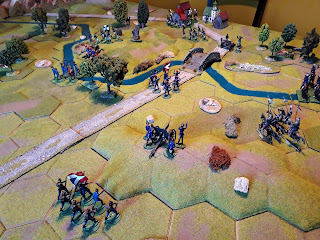Following up on my previous post, in this post I explain a bit more the design of my card-driven narrative wargame, and what the core ideas are. Write-ups such as these also help me to structure my own thoughts (I'm an academic, after all).
Overall goal
The goal is to create a narrative for a battle, not as an after-the-game fact, but actually through gaming mechanics while the game is being played. I drew inspiration from some story-based games which use similar mechanics.
All players play both sides
The game does not assign a player to play a single side. The default "position identification" for a player in a wargame is to be the commander-in-chief for one army. But I have always been interested in experimenting with that model, and give the player different roles. E.g. the player can be a commander of one particular unit, or be a war chronicler following the army, or even be a civilian bystander observing the battle. This also puts no restriction on the number of players that can participate in the game.
To nudge the players in this variety of position, each player draws a number of "mission cards", which essentially are little micro-events that might happen during the battle. When such an event will take place, the player scores some points. There are 1, 2 and 3-point mission cards. The 1 point mission cards are rather trivial events, but the 3 point cards outline major goals.
The mission cards for each player can specify objectives both for Red and Blue, hence the player is also forced to detach himself from one particular side.
Let's illustrate this with each of 4 possible "draws", and thereby showing all of the mission cards I had prepared for the game. Each hand has 6 mission cards (three 1 point cards, two 2 point cards, and one 3 point card), so a player can score 10 points total).
By providing each player with a set of mission cards, the player should try to achieve these micro-events, rather than try to "win" the battle. The battle is a mere backdrop during which all sort of events take place.
Scenario Deck
A second component of the game is the "scenario deck". This is a series of subdecks, each governing different phases of the battle. In the river crossing scenario I ran, there were 3 subdecks, each with increasing intensity.
The idea is that a player - during his turn - draws a card from the scenario deck and does whatever the card says. This could be introducing a narrative element in the battle, e.g. naming a unit or a terrain feature. Some cards also encourage a dialogue between players. The idea is to create a common narrative. Sometimes small post-its were added to units or terrain features as a result of some of the names given to them.
Each subdeck also comes with its own restrictions about where units can move, whether combat is allowed, etc., thereby controlling the "build up" of the battle as a whole. Each subdeck also has a fixed start and end card, but the remaining cards should be shuffled. I opted to have 13 cards per subdeck, because that leaves open the possibility of using ordinary playing cards and reading the card text from an indexed table.
Let's give an example: in my river crossing scenario, I had 3 subdecks: the "deployment" deck (in which the focus lies on deploying the troops an setting the narrative), the "opening manoeuvres" deck, in which units could move up to the river, but fighting was not yet allowed, and the "battle" deck, in which there were no restrictions.
The cards for the "deployment deck" are as follows:
The "opening manoeuvres" deck:
The "battle" deck:
You can see that the focus changes from having a lot of narrative elements in the first subdeck, towards more battle oriented actions in the last deck.
Player Action
After a player has finished the card, he can take a player action. A player action - depending on the subdeck - involves activating 1, 2 or 3 units from either side. The underlying idea is that the player can take control of units to achieve his goals as stated in the mission cards.This requires a set of "tactical" rules that are based on individual unit activation, which in principle can be orthogonal to the scenario deck.
By increasing the number of units a player can activate, the "intensity" of the battle also increases as the game progresses.
Thus, a player's turn consists of 2 elements: a card drawn from the scenario deck, and a player action. This provides a nice balance between deck-generated questions and free choice by the player.
Playtest
We had a first playtest of this design, with 3 exerienced wargamers: Eddy, Jean-Pierre, and myself. Bart had to cancel at the last moment.
As can be expected from wargamers, there were some remarks about the tactical rules used (these were "toy soldier" style, nothing too complicated) and the balance of the scenario, but I was much more interested in the design framework of the subdecks and how the narrative elements were experienced.
Some comments made by Eddy and Jean-Pierre:
- "The restrictions on the cards about where to move and whether or not too fight felt somewhat artificial."
- "The narrative elements worked fine, but perhaps are not for everyone. Only for experienced wargamers who like to think out-of-the-box."
- "There was not a good mix of mission cards in my hand."
- "The narrative questions on the cards forces players to engage - which is a good thing in a multi-player game."
- "Some mission cards forced me to do things I would not have done in a more classic game."
So, we agreed we should certainly try it again. Whether it will be the same scenario or a different one is still to be decided.








































